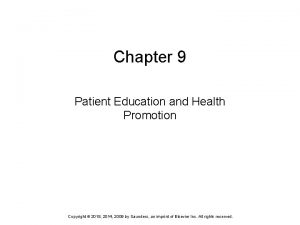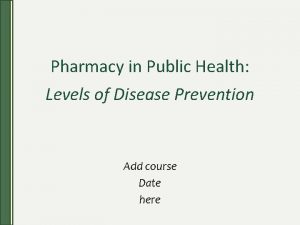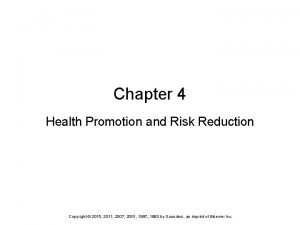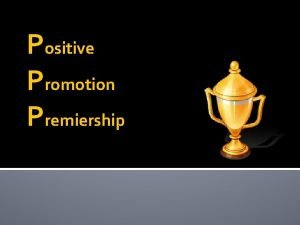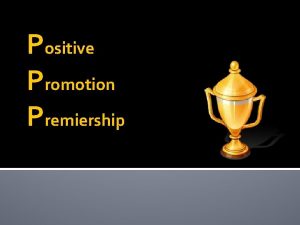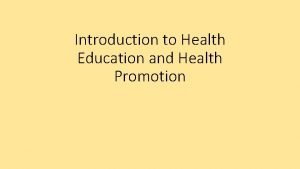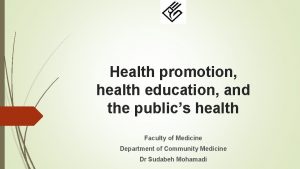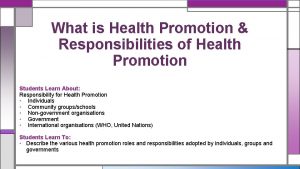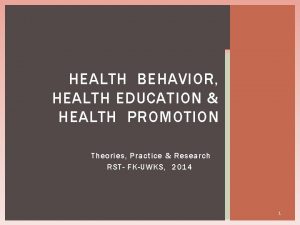Chapter 9 Patient Education and Health Promotion Copyright
























- Slides: 24

Chapter 9 Patient Education and Health Promotion Copyright © 2018, 2014, 2009 by Saunders, an imprint of Elsevier Inc. All rights reserved.

Lesson 9. 1 Patient Education and Factors Affecting Teaching/Learning Theory 1) Discuss the purposes of patient education. 2) Use patient teaching to promote the national goals of health promotion and disease prevention as listed in Healthy People 2020 and the Canada Health Act. 3) Describe three ways in which people learn and correlate the importance of these types of learning to teaching. 4) List and differentiate between conditions and factors that can affect learning. Copyright © 2018, 2014, 2009 by Saunders, an imprint of Elsevier Inc. All rights reserved.

Lesson 9. 1 Title Theory 5) 6) 7) 8) 9) Describe barriers to teaching and learning. Identify adjustments to the teaching plan needed for teaching the very young patient or the older patient. Discuss types of resources available to assist in patient teaching. Name three things that must be included in the documentation of patient teaching. Describe ways in which teaching can be continued following hospital discharge. Copyright © 2018, 2014, 2009 by Saunders, an imprint of Elsevier Inc. All rights reserved.

Lesson 9. 1 Title Clinical Practice 1) Assess an assigned patient’s learning needs. 2) Develop a teaching plan based on the patient’s learning needs. 3) Implement the teaching plan at a prearranged time. 4) Evaluate the effectiveness of the teaching and the plan. Copyright © 2018, 2014, 2009 by Saunders, an imprint of Elsevier Inc. All rights reserved.

Purposes of Patient Teaching Preventing illness or promoting wellness Nurses teach patients about their: Disease or disorder Ø Diet and medications Ø Treatment and self-care Ø Prior to discharge, the patient must be taught how to care for himself at home Patient teaching begins at time of admission Copyright © 2018, 2014, 2009 by Saunders, an imprint of Elsevier Inc. All rights reserved.

Purposes of Patient Teaching (cont’d) Assessment of learning needs Ø Factors affecting learning Ø Prepare a plan, assess learning needs Cultural values, confidence and abilities, readiness to learn Form a teaching plan Ø Collaborate with other health professionals Copyright © 2018, 2014, 2009 by Saunders, an imprint of Elsevier Inc. All rights reserved.

Modes of Learning Visual learning Ø Auditory learning Ø Through what they see Through what they hear Kinesthetic learning Ø By actually performing a task or handling items Copyright © 2018, 2014, 2009 by Saunders, an imprint of Elsevier Inc. All rights reserved.

Assessment of Learning Needs To prepare a teaching plan, assess patient for: Knowledge of his disease Ø Diet (if related to disease or condition) Ø Activity regimen or limitations Ø Medications (prescription and OTC) Ø Self-care at home Ø Prioritize learning needs so you can concentrate on teaching essential knowledge first Copyright © 2018, 2014, 2009 by Saunders, an imprint of Elsevier Inc. All rights reserved.

Factors Affecting Learning Assess for factors that might interfere with the patient’s ability to learn Ø Poor vision or hearing, impaired motor function, illiteracy, and impaired cognition Age may interfere with the strength or dexterity for performing certain tasks Copyright © 2018, 2014, 2009 by Saunders, an imprint of Elsevier Inc. All rights reserved.

Special Considerations for Teaching the Elderly Provide good lighting Provide printed teaching materials in large type Encourage patient to wear glasses if needed Encourage patient to wear and adjust hearing aids Use short sentences and pause frequently Keep medical terms to a minimum Ask questions at frequent intervals Copyright © 2018, 2014, 2009 by Saunders, an imprint of Elsevier Inc. All rights reserved.

Readiness to Learn Assess patient’s readiness to learn Motivation plays a large role in effective learning Work with patients to show them the advantages of learning what they need to know Copyright © 2018, 2014, 2009 by Saunders, an imprint of Elsevier Inc. All rights reserved.

Cultural Values and Expectations Need to work within patient’s values and cultural system Values and expectations can interfere with patient’s ability to cooperate and learn needed skills for self-care Copyright © 2018, 2014, 2009 by Saunders, an imprint of Elsevier Inc. All rights reserved.

Confidence and Ability Often patients express a lack of selfconfidence Teaching may need to be broken down into very small steps Assess what patients already know about the skills they need to learn so that you can build on their current knowledge base Copyright © 2018, 2014, 2009 by Saunders, an imprint of Elsevier Inc. All rights reserved.

The Patient Education Plan Preparing the teaching plan includes: Analyzing assessment data Ø Establishing behavioral objectives Ø Creating a plan to assist patient in reaching the goals in a timely and effective manner Ø Essential that teaching plan be developed collaboratively, with input from all of the disciplines involved in the patient’s care Copyright © 2018, 2014, 2009 by Saunders, an imprint of Elsevier Inc. All rights reserved.

Resources for Patient Education Books, audiovisual materials, pamphlets, and hands-on equipment Local government agencies often provide printed and online listings of community public service programs Hospital social workers and patient representatives also good sources of information Copyright © 2018, 2014, 2009 by Saunders, an imprint of Elsevier Inc. All rights reserved.

Implementing the Plan Teaching done when visitors, physician rounds, and treatments will not cause interruptions One-on-one or in a group setting Patient should be comfortable Keep teaching session short Involve patient in the process You may need to incorporate teaching into daily care Copyright © 2018, 2014, 2009 by Saunders, an imprint of Elsevier Inc. All rights reserved.

Evaluation Involves obtaining feedback from the patient regarding what was taught Use this feedback to determine whether effective learning has in fact taken place Copyright © 2018, 2014, 2009 by Saunders, an imprint of Elsevier Inc. All rights reserved.

Documentation Every staff nurse legally responsible for providing patient education: documentation is essential Patient education flow sheet may be used Nurse’s notes should include: Specific content taught Ø Method of teaching used Ø Evidence of evaluation with specific results Ø Copyright © 2018, 2014, 2009 by Saunders, an imprint of Elsevier Inc. All rights reserved.

Coordination with Discharge Planning Specific learning needs should be discussed with all involved parties, including the patient, and the plan for teaching shared Primary physician’s office Ø Home health services Ø Family or significant others Ø Printed plan must be sent home with the patient Copyright © 2018, 2014, 2009 by Saunders, an imprint of Elsevier Inc. All rights reserved.

Question 1 As a nurse, Rachel knows that teaching a patient is done to assist the prevention of illness or promotion of wellness. All of the following are true regarding patient teaching except: 1) 2) 3) 4) it is a process that begins within 48 hours of admission. the patient must be taught how to care for himself at home before discharge. nurses teach patients what they need to know about their disease or disorder, diet, medications, treatments, and self-care. discharge planning requires looking ahead to what the patient will be facing when returning home. Copyright © 2018, 2014, 2009 by Saunders, an imprint of Elsevier Inc. All rights reserved.

Question 2 Madison is a student nurse who finds it easier to learn by performing a task. This is which type of learning? 1) 2) 3) 4) Visual learning Auditory learning Kinesthetic learning Affective learning Copyright © 2018, 2014, 2009 by Saunders, an imprint of Elsevier Inc. All rights reserved.

Question 3 Henry is a nurse working in a physician’s office setting. If he is teaching a patient to draw up insulin and watches the patient perform this task, he is teaching in which domain? 1) 2) 3) 4) Cognitive domain Affective domain Effective domain Psychomotor domain Copyright © 2018, 2014, 2009 by Saunders, an imprint of Elsevier Inc. All rights reserved.

Question 4 Cara is working in a rural health department. She spends most of her day teaching patients and families. She realizes several factors affect learning. Which one of the following choices affects learning? 1) 2) 3) 4) 5) Cultural values and expectations Confidence and abilities Readiness to learn Environmental factors All of the above Copyright © 2018, 2014, 2009 by Saunders, an imprint of Elsevier Inc. All rights reserved.

Question 5 Holly is working in a geriatric setting. She understands when teaching the elderly she should: 1) 2) 3) 4) keep the TV on and turned up loud so the other patients can hear it. use long sentences and speak rapidly to keep their attention. use medical terms to describe all procedures and information. review the information frequently and check for comprehension. Copyright © 2018, 2014, 2009 by Saunders, an imprint of Elsevier Inc. All rights reserved.
 Chapter 9 patient education and health promotion
Chapter 9 patient education and health promotion Difference between health and health education
Difference between health and health education Health promotion world health organization
Health promotion world health organization Pcb 3703c ucf
Pcb 3703c ucf Patient 2 patient
Patient 2 patient Health propaganda definition
Health propaganda definition 5 approaches to health promotion
5 approaches to health promotion Health promotion and levels of disease prevention
Health promotion and levels of disease prevention Health promotion and levels of disease prevention
Health promotion and levels of disease prevention Caplan and holland model of health promotion
Caplan and holland model of health promotion Chapter 3 health wellness and health disparities
Chapter 3 health wellness and health disparities Chapter 1 understanding health and wellness lesson 2
Chapter 1 understanding health and wellness lesson 2 Understanding your health and wellness chapter 1
Understanding your health and wellness chapter 1 Adventist education promotion
Adventist education promotion Pearson education ltd
Pearson education ltd Copyright by pearson education inc. answers
Copyright by pearson education inc. answers 2010 pearson education inc
2010 pearson education inc Copyright 2009 pearson education inc
Copyright 2009 pearson education inc Copyright pearson education inc
Copyright pearson education inc 2014 pearson education inc
2014 pearson education inc Copyright 2010 pearson education inc
Copyright 2010 pearson education inc Copyright 2010 pearson education inc
Copyright 2010 pearson education inc Copyright by pearson education inc. answers
Copyright by pearson education inc. answers Copyright 2003 pearson education inc
Copyright 2003 pearson education inc Copyright 2009 pearson education inc
Copyright 2009 pearson education inc
